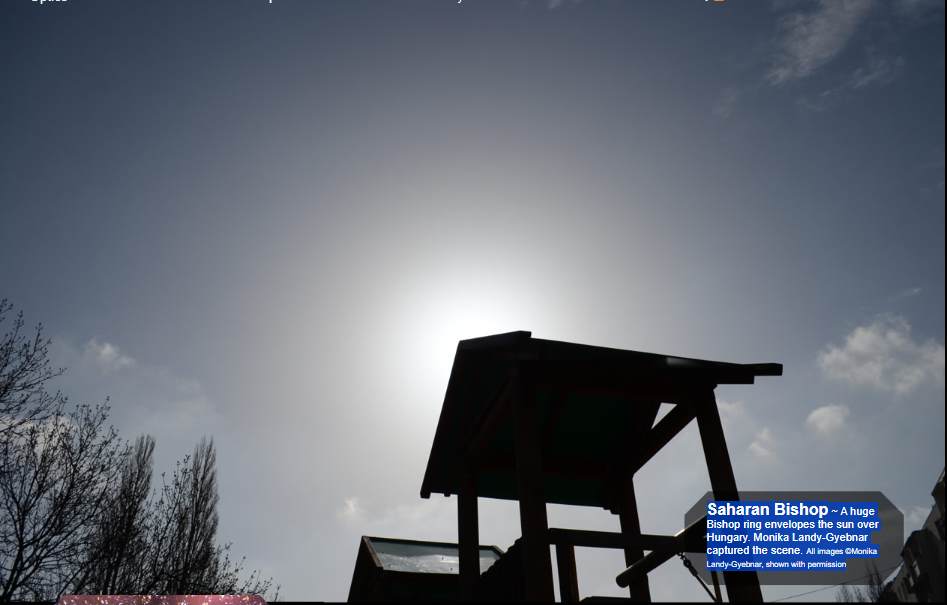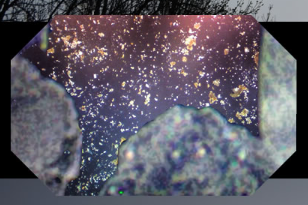Sahara Dust Bishop Ring - OPOD
Sahara Dust Bishop Ring - A Spectacular Atmospheric Phenomenon
The Sahara Dust Bishop Ring is a breathtaking atmospheric optics phenomenon that occurs when a massive cloud of Saharan dust crosses the Mediterranean into Central Europe. This event is not only visually stunning but also has interesting effects on the surrounding environment. In this article, we will explore the details of this phenomenon and its impact on the atmosphere.
The Appearance of the Sahara Dust Bishop Ring
When the Saharan dust cloud reaches Central Europe, it can create various atmospheric effects. One of the most remarkable sights is the appearance of a huge Bishop ring around the Sun. This ring has a radius of approximately 25 degrees and is characterized by a bluish color near the Sun, transitioning into a pastel red edge. The ring is a form of aureole or corona, which is produced when tiny particles or droplets diffract sunlight.
The Origin of the Sahara Dust
The source of the Sahara dust is, as the name suggests, the vast Sahara Desert in Northern Africa. Winds in this region can pick up dust particles and carry them across long distances. In February, an unusually large cloud of Sahara dust made its way into Central Europe, causing various phenomena such as "red" snow in the Italian Alps and muddy rain in countries like Croatia, Slovenia, Hungary, and Czech Republic.
Unusual Timing and Impact
The arrival of such a dusty Saharan air mass in Central Europe during February was highly unusual. Normally, the first dust arrives in April, with occasional events occurring until early August. However, this particular event took place out of season, surprising many observers. The presence of the Saharan dust had notable effects on the atmosphere, including a significant reduction in visibility during the evening. Stars appeared dimmer than usual, with Jupiter seeming to be less bright and constellations like the Pleiades and Orion's belt becoming difficult to see.
The Role of Particle Size and Composition
The formation of the Bishop ring relies on the presence of tiny particles or droplets in the atmosphere that can diffract sunlight. While sulfate particles or droplets from volcanic activity in the stratosphere are commonly associated with the creation of aureoles, this particular phenomenon demonstrates that even small tropospheric particles are sufficient to produce the Bishop ring. In the case of the Saharan dust cloud, the tiny sand grains carried by the wind played a crucial role in generating this mesmerizing optical display.
The Beauty and Transient Nature of Atmospheric Optics
The Sahara Dust Bishop Ring serves as a reminder of the beauty and complexity of atmospheric optics. These phenomena are often transient, appearing for a brief period before dissipating. Observing such rare events provides us with a unique opportunity to appreciate the wonders of our atmosphere and gain a deeper understanding of the intricate processes at work.
Conclusion
The Sahara Dust Bishop Ring is a remarkable atmospheric optics phenomenon that occurs when a massive cloud of Saharan dust reaches Central Europe. This event, which took place out of season in February, created stunning visual effects, including a magnificent Bishop ring around the Sun. The presence of tiny sand grains in the atmosphere diffracted sunlight, giving rise to this breathtaking display. By appreciating these natural phenomena, we can gain a greater appreciation for the intricacies of our atmosphere and the wonders it holds.

Saharan Bishop ~ A huge Bishop ring envelopes the sun over Hungary. Monika Landy-Gyebnar captured the scene. All images ©Monika Landy-Gyebnar, shown with permission

At left the Saharan sand grains are tiny compared with those of builders' sand.
"In February a huge cloud of Sahara dust crossed the Mediterranean into Central Europe. It created "red" snow in the Italian Alps and muddy rain across Croatia, Slovenia, Hungary and Czech Rep. leaving ugly mud marks on cars.
Next day as the clouds parted a ~ 25 degree radius, spectacular Bishop's ring appeared around the Sun. In the evening the stars were very dim, Jupiter seemed to be not brighter than 0 magnitude (instead of -2), I could not see the Pleiades and the belt of Orion.
Usually the first dust arrives here in April and we might get some more events until early August, but it is rare to have such a dusty Saharan air mass reach Central Europe so out of season."

The Bishop ring is characteristically bluish near the sun with a pastel red edge.
It is a form of aureole or corona produced when tiny particles or droplets diffract sunlight.
Sulfate particles/droplets in the stratosphere from volcanoes are favourite sources but - as here - small tropospheric particles suffice.
Note: this article has been automatically converted from the old site and may not appear as intended. You can find the original article here.
Reference Atmospheric Optics
If you use any of the definitions, information, or data presented on Atmospheric Optics, please copy the link or reference below to properly credit us as the reference source. Thank you!
-
<a href="https://atoptics.co.uk/blog/sahara-dust-bishop-ring-opod/">Sahara Dust Bishop Ring - OPOD</a>
-
"Sahara Dust Bishop Ring - OPOD". Atmospheric Optics. Accessed on November 25, 2024. https://atoptics.co.uk/blog/sahara-dust-bishop-ring-opod/.
-
"Sahara Dust Bishop Ring - OPOD". Atmospheric Optics, https://atoptics.co.uk/blog/sahara-dust-bishop-ring-opod/. Accessed 25 November, 2024
-
Sahara Dust Bishop Ring - OPOD. Atmospheric Optics. Retrieved from https://atoptics.co.uk/blog/sahara-dust-bishop-ring-opod/.